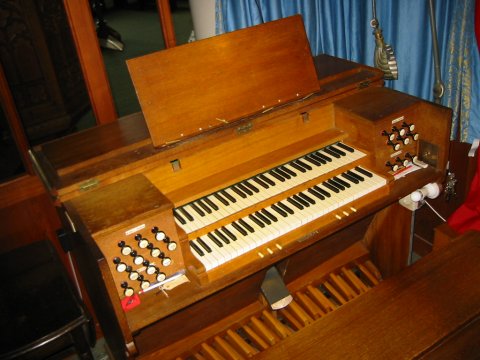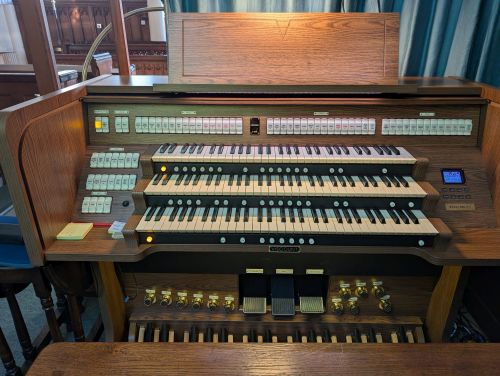Each section is on a seperate page:
Early History - 1977-2003 - 2003 Onwards - Organists - Methodist Chapel
Early Years
Sadly, nothing is known of the first organ built in 1837 although it is believed to have been in the gallery. The second organ of 1875 was Hill's Opus 1571. It was probably supplied initially with a single manual and pedal in a pitch pine case costing £200 and was probably brought into use during November 1875.
|
Manual
|
|
Pedal
|
|
| Open Diapason | 8 | Bourdon | 16 |
| Dulciana | 8 |
|
|
| Hohl Flute | 8 |
|
|
| Principal | 4 |
|
|
| Fifteenth | 2 |
|
|
| Oboe | 8 |
|
|
It had mechanical action and the manual pipework was enclosed.
In 1882, Hill added a four stop Swell and transferred the swellbox from the Great to house it. The Swell stops were: Gamba, Rohr Flute, Gemshorn, Oboe (from Great). The notes of the bottom octave were coupled to the Hohl Flute and a Swell to Great coupler was provided. On the Great, a Wald Flute 4 replaced the Oboe. Total cost was £95.
In 1911, Liddiat - a local builder - installed a three manual instrument with tubular pneumatic key and stop action. There was a detached console with a concave parallel pedalboard with a 30 note compass from C to f1. The manual compass was 56 notes from C to g3.
The specification was as follows:
|
Pedal
|
|
Choir
|
|
| Large Bourdon | 16 | Small Open Diapason | 8 |
| Lieblich Bourdon (Swell) | 16 | Viol da Gamba | 8 |
| Bass Flute (Ext) | 8 | Wald Flute | 4 |
|
|
|
Cremona | 8 |
|
Swell
|
|
Great
|
|
| Lieblich Bourdon | 16 | Open Diapason | 8 |
| Rohr Flute | 8 | Hohl Flute | 8 |
| Gamba | 8 | Dulciana | 8 |
| Celeste | 8 | Principal | 4 |
| Gemshorn | 4 | Fifteenth | 2 |
| Oboe | 8 | ||
| Octave Coupler |
Swell to Great
Swell to Choir
Swell to Pedal
Choir to Great
Choir to Pedal
Great to Pedal
Blowing: electric
Lever pedal; 3 pistons Great, 3 Swell
The Cremona was subsequently displaced by a Trompette, possibly by Osmond, in 1962.
[Thanks are due to Roy Williamson for much of the above data]
1977 - 2003
In 1976, the original 3 manual Liddiat organ was in poor condition. It was built using cheap Weigle sliderless soundboards, pneumatic action, and the thin leather membranes involved, called splitskin, were becoming hard. The Choir organ soundboard had suffered from a water spillage and a total overhaul and releathering was essential.
The Bristol organ builder John Coulson was consulted and offered to do the work on the Choir organ, but in view of the deteriorating condition of the rest of the organ proposed a major rebuild using the original pipes, but new, traditional slider soundboards.
The concept was accepted by the church and a scheme put forward by John Coulson, Cecil Adams - the organ advisor, and Sheila Foster - the then organist.
Excellent refurbished soundboards were obtained from the redundant Anglican church of Emmanuel in Clifton, Bristol. A two manual, electric action scheme was agreed and the final specification was:
| Great | Swell | ||
| Open Diapason | 8 | Rohrflote | 8 |
| Hohl Flute | 8 | Gamba | 8 |
| Principal | 4 | Voix Celeste | 8 |
| Nason Flute | 4 | Gemshorn | 4 |
| Nazard | 2 2/3 | Fifteenth | 2 |
| Fifteenth | 2 | Tierce | 1 3/5 |
| Mixture | II | ||
| Oboe | 8 | ||
| Tremulant | |||
| Super Octave | |||
| Pedal | Couplers | ||
| Bourdon | 16 | Swell to Great | |
| Bass Flute | 8 | Great to Pedal | |
| Flute | 4 | Swell to Pedal | |
The Swell Fifteenth Swell 15th was derived from the Choir Open Diapason plus 2 octaves of trebles and the Tierce pipes were from the Choir 4ft Flute plus 28 trebles. The Nason Flute was made up of ex Great Dulciana pipes, stoppered plus 12 trebles. The Mixture was new pipes and the Nazard from second-hand ones.
The three pedal stops are one extended rank.
As can be seen from the above, much of the pipework is from the original Hill instrument.
The rebuild was completed in 1978 at a total cost of £8283 and the rededication was on 24 September 1978.

Obviously, the Church wished to ensure that the organ remains sound for many decades to come and to that end agreed to a 20 year spring clean which was carried out in May 1996. This involved the removal and cleaning of all the pipework and the cleaning and general maintenance of all the other parts of the organ.
In 1996, one of the matching keyboards from the Littleworth Chapel organ was fitted, returning the console to its original 3 manual layout. This (top) manual acted as a MIDI keyboard to drive any external electronic MIDI instruments.

In 2002, following on from a year of study and investigation, the PCC agreed to a number of improvements and extensions to the organ. The Diocesan Organ Advisor was consulted and a faculty obtained. The work was completed in March 2003.
The rebuild of 1977 was a generally good compromise between size, cost and flexibility and gave us the organ we had up until this time. Although the organ had a relatively small number of stops, the majority are of excellent quality and very well voiced.
However there were also a number of shortcomings. The pedal department was very basic having only one rank of pipes. Secondly, there was a lack of power for leading large congregations. Thirdly, there was a lack of variety in the available soft stops especially on the Great. Lastly, there were no modern playing aids such as adjustable thumb and toe pistons.
As a result of this, the intention was to improve significantly the pedal department, to add to the flexibility of both manuals with a few well-chosen stops both loud and soft and to add modern playing aids. The aim was to enable a proper balance of sound between manuals and pedals at all volume levels. We were not trying to emulate a cathedral organ, only trying to bring the size and flexibility of the organ (acoustically) into keeping with the size of the building and of the congregations.
The specification is given below - additional stops are in italic
Great
|
Swell
|
Pedal
| Open Wood | 16 |
| Bourdon | 16 |
| Octave | 8 |
| Bass Flute | 8 |
| Flute | 4 |
| Fagotto (from Swell) | 16 |
| Trombone | 16 |
5 thumb pistons to Great - 5 thumb pistons to Swell
5 general thumb pistons
Reversible thumb pistons for all couplers
Reversible thumb pistons for Trumpet and Tuba
Capture and cancellation thumb pistons
8 piston memories
Automatic temperature-compensated pitch matching
Full MIDI In and Out functionality
* The Solo Tuba is played from the Swell manual. When it is drawn, only the tuba plays from the Swell manual, however any other stops drawn on the Swell will continue to play through the Swell to Great and Swell to Pedal couplers.
The rebuild was completed in March 2003 at a cost of slightly less than £12,000 and the reopening concert by David Briggs took place on 6th June 2003. David returned to give another recital on 16th July 2010.

By 2018 the condition of the organ was deteriorating quite badly. The keyboards and pedalboard were on their last legs with an increasing number of 'sticky' notes. The action had become very noisy as the leathers hardened and maintaining tuning was ever more problematic. All of this was of course down to age - the soundboards were now well over 100 years old and the leatherwork nearly 50.
In 2025, with ever increasing problem, something had to be done. The pipe part of the organ was continually becoming ever more problematic and the digital part, although working fairly well, was reaching its end of life and no replacement parts were available. The cost of rebuilding solely the pipe organ part was well into six figures which was neither within our reach not morally justifiable given the ever decreasing congregation. With the support of the DAC and the DOA, the organ was 'retired' and the console replaced with a Viscount digital organ.

The new organ replaces almost exactly the old console and the speakers are mounted high in the old organ chamber which is being converted into a new vestry, The display pipes will remain so there are no visual changes in the church at all.
Technology changes and the church moves on but organ music continues to be a fundamental part of our worship.
So far, early records have not been forthcoming. However we do have the following:
c1916 - 1946 Mr Kiddle
1947 - 1962 Mary White
1962 - 1966 David Smith
1967 - 1970 Edgar Dyer
1971 - 1982 Sheila Foster
1982 - 1988 Harry Lyall
1989 - date Steve Goodwin
Littleworth Methodist Chapel
The Anglicans and Methodists in Amberley are now in covenant and share the Parish Church. The Littleworth Methodist Chapel is now a private house and the organ (which was in very poor condition) was removed in 1992.
The first organ was built in 1877 and was second-hand. In 1920, Liddiat built a new organ and rebuilt the old organ for a church in Wales.
It used tubular pneumatic action throughout
The woodwork of the console survives as a set of bookshelves in the Choir vestry of the Parish Church!
The specification was as follows:
Pedal
Bourdon 16
Swell
Stop Diapason 8
Horn Diapason 8
Gemshorn 4
Celeste 8
Oboe 8
Great
Open Diapason 8
Clarabella 8
Dulciana 8
Principal 4
Flute 4
Swell to Great
Swell to Pedal
Swell octave
Great to Pedal
Swell Super Octave
Blowing: Electric
Ratchet Swell pedal
